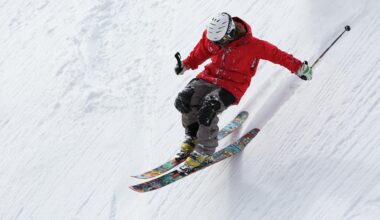Advanced Passing Techniques for Point Guards
Point guards are often termed the “floor generals” of basketball. Their primary role is to orchestrate the team’s offense. An essential skill for a point guard is the ability to deliver accurate passes under various game situations. Mastering advanced passing techniques can enhance a player’s effectiveness on the court. To achieve this, focusing on different types of passes is crucial. For excellence in passing, a point guard should be aware of a few key techniques. First, ensure your body is positioned correctly for optimal passing. Also, it’s important to maintain a low dribble to protect the ball. Second, practice passing with both hands to enhance versatility. Passing volume and speed also play significant roles in execution and effectiveness. Third, develop keen court vision to anticipate teammate movements and defensive setups. Working on these elements can facilitate better pass delivery. Lastly, understanding defensive schemes will inform decision-making. Point guards should continuously practice these passing techniques to improve their performance and to contribute to their team’s overall success.
Types of Passes
Point guards utilize various passing styles based on on-court scenarios. Among the essential passes include the chest pass, bounce pass, and overhead pass. Each has specific situations where they shine, helping to facilitate seamless ball movement. The chest pass is straightforward and ideal for quick, direct exchanges. To execute this, keep your thumbs behind the ball while extending your arms. The bounce pass, on the other hand, is effective when passing to a teammate surrounded by defenders. Aim for a spot on the floor about two-thirds to three-quarters of the way to your target. Finally, the overhead pass is suited for longer distances, ideal for skipping over defenders. Point guards should familiarize themselves with these types of passes to maximize scoring opportunities. Practicing each pass frequently can enhance muscle memory and ball control. Additionally, recognizing the right context for each pass can make a significant difference in a game. Understanding spacing and timing is essential, as it informs when each pass will be most effective, thus improving team chemistry on the court.
Practicing advanced passing techniques requires consistency and purpose. It’s essential for point guards to dedicate practice time to refine these skills. Running drills specifically targeting passing can be beneficial during training sessions. Start with partner passing drills, focusing on weight transfer and body positioning. Introduce moving targets by using cones or employing teammates in specific patterns. Progress onto full-speed situations where you’re dribbling while passing to enhance fluidity and natural movement. The inclusion of defensive scenarios in practice can elevate the challenge, preparing players for game-like environments. Point guards should also record their passing practices to analyze performance. Watching footage reveals habits and common mistakes, allowing for targeted improvements. Furthermore, understanding the individual strengths of teammates can dictate passing strategy. Open discussions about preferred passing styles will enhance team synergy. Over time, establishing a rhythm with teammates will lead to smoother gameplay during high-pressure moments. Devoting time to practice these targeted skills as a point guard will significantly enhance overall effectiveness and can elevate the entire team’s performance.
Passing Under Pressure
Passing under defensive pressure is a hallmark of a successful point guard. At times, defenders can be aggressive, requiring players to remain calm and effective. Recognizing defensive schemes, including traps or intense guarding, can inform clever passing decisions. First, learn to read the defense: communicate with teammates to create opportunities or relieve pressure. Developing deceptive passing skills like no-look passes or behind-the-back passes can create openings. These techniques often draw defenders away from intended targets, enhancing accuracy and effectiveness. Ensure you practice these deception techniques under real game conditions to build confidence. Team chemistry also plays a significant role; synchronized movements lead to smooth passing. Utilize eye contact or subtle signals to indicate the intended recipient while maintaining focus on the pressure, ultimately improving teamwork. Lastly, maintaining ball control under pressure is crucial. Dribbling with poise while anticipating defensive shifts will aid quick decision-making in game scenarios. Engaging continuously in drills that simulate pressure can elevate comfort levels significantly. Over time, strategic passing will emerge as a natural instinct, positioning point guards as playmakers on the court.
Consequently, mental agility is essential in passing techniques. Point guards must cultivate quick thinking and awareness to thrive. This mental preparation is critical as it enables players to react to fast-paced scenarios effectively. A strong basketball IQ, highlighted by understanding players’ habits and positioning, boosts passing efficiency. Visualization techniques can significantly expand a player’s mindset as well. Imagine various scenarios where the ball will be passed, practicing mental rehearsals during downtime. Additionally, watching professional games allows aspiring point guards to gain exposure to effective passing techniques in action. Take notes on successful plays and attempt to integrate those tactics into practice. Emulate professional point guards known for exceptional passing skills, studying their decision-making processes during games. Regular self-evaluation and adjustment are also beneficial. Encourage open dialogue with coaches for constructive criticism and feedback. Keeping a journal of passing improvements, challenges, and strategies can aid in focused development as a player. Balancing physical and mental skill development is essential for forming a well-rounded and effective point guard.
The Role of Footwork in Passing
Good footwork is a significant factor affecting passing techniques. Point guards must develop proper footwork to create passing angles effectively. The stance before making a pass dictates both speed and accuracy. Begin rehearsing basic footwork drills, such as jump stops and pivots, to foster agility. Utilize cones for dribbling drills that focus on changing directions quickly—this allows for better passing opportunities. Lateral movement exercises with defensive pressure will also strengthen footwork. Auxiliary moves like the jab step can create space, providing crucial time to find open teammates. Ensure your feet are always positioned correctly; the toes should point toward the target during a pass. Additionally, footwork contributes to balance. A stable base enhances control, allowing for precision during critical moments on the court. Practice combining footwork with passing drills to integrate these skills seamlessly. Footwork requires continuous development and should be routinely practiced in combination with passing to enhance synergy. Over time, these foundational skills will improve overall effectiveness and boost confidence, making point guards more adept playmakers on the court.
Mastering advanced passing techniques is crucial for point guards who aspire to lead their teams effectively. Players should acknowledge that improving these skills involves understanding their strengths and weaknesses. Regular feedback from coaches can illuminate necessary focus areas. Passionate practice, alongside game analysis, will enhance performance significantly. Furthermore, developing leadership skills will allow point guards to communicate effectively on the court. This communication fosters team trust, crucial in creating seamless gameplay. Continuous engagement with experienced players and understanding their experiences will reveal insights beneficial to mastering passing techniques. Building a network in the basketball community allows aspiring point guards to share tips, strategies, and mentorship. Players must remain patient through their development journey; mastering advanced skills takes time and dedication. Celebrate small victories, and consistently refine techniques in every practice session. Keep a positive mindset and seek inspiration from role models. Ultimately, through unwavering commitment and tireless practice, point guards will elevate their passing abilities, thus shaping their journey towards becoming exemplary floor leaders in basketball.


